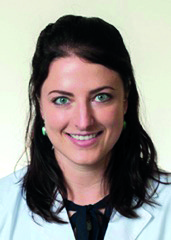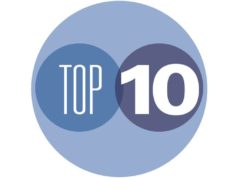
Daryl Goldman, Suroosh Marzban, and Robert Rosen highlight the use of catheter-based techniques for the treatment of Parkes Weber syndrome in children. Summarising their recent work, presented at the Society for Interventional Radiology 2019 conference (SIR; 23–28 March, Austin, USA), Goldman et al detail how it demonstrates the feasibility and safety of embolization for treating arteriovenous malformations associated with the disease, and expands on the key role paediatric interventional radiology has to play in the multidisciplinary management of this rare disorder.
Parkes Weber syndrome (PWS) is a rare congenital vascular disorder characterised by high-flow arteriovenous malformation, limb hypertrophy, and port wine stain. PWS was first described by Frederick Parkes Weber in 1907, who reported on two patients with limb hypertrophy, port wine stain, and vasculature with pulsatile thrill. The etiology is not well understood, but PWS has been associated with mutations in the RASA1 gene, which codes for various growth factor receptor signals involved in proliferation, migration, and survival of vascular endothelial cells. The exact prevalence of PWS is unknown, and PWS carries an associated mortality rate of approximately 1%.
Arteriovenous malformations are often the most debilitating of the PWS triad, causing a wide variety of clinical features such as pain, fatigue, ulceration, and high-output congestive heart failure. Unfortunately, arteriovenous malformations remain a significant challenge to treat given a high recurrence rate and the morbidity associated with surgical resection. Catheter-based techniques have emerged as the preferred mode of therapy. Catheter-based techniques for treatment of high-flow arteriovenous malformations consist of embolization with various types of embolics including acrylic adhesives, EVAL, sclerosing agents including ethanol, coils, and microspheres. The arteriovenous malformations of PWS are not completely curable given the diffuse nature of the disease with multiple areas of small vessel shunting. They also tend to recruit new collateral vessels that contribute to the recurrence of symptoms. Therefore, the goals of management are to improve symptoms and slow disease progression from childhood, including the development of heart failure and limb hypertrophy. The clinical manifestations can be unusually severe in PWS compared to other AVMs, with a significant incidence of tissue loss (ulceration, amputation) and high output states.
The purpose of our study, presented at the SIR conference in Austin, was to describe the safety, feasibility, and efficacy of catheter-based therapy for the treatment of high-flow arteriovenous malformations in paediatric patients with PWS. A retrospective review was performed from January 2004 to January 2018 to identify patients with PWS who underwent diagnostic angiography of arteriovenous malformation. Nine paediatric patients were included in this study (mean age: eight, range: five to 16; four male, five female). Treatment response (relief of symptoms), technical success, lesion characteristics, procedural details, and adverse events were recorded.
Two of nine patients (22.2%) were affected in the upper extremity and seven of nine (77.7%) in the lower extremity. Presenting symptoms included pain (in 100% of patients), edema (in eight of the nine patients, 88.8%), ulcer (in three of nine patients, 33.3%), difficulty ambulating (in four patients, 44.4%), and high-output cardiac failure (in five patients, 55.5%). Three (33.3%) patients were found to have diffuse arteriovenous communication without a discrete arteriovenous malformation nidus and thus were not treated with embolization. Six (66.6%) patients were treated with transcatheter embolization of the arteriovenous malformation’s arterial inflow. Four (66.6%) required multiple inflow embolization procedures (median, four; range, one to 10). Twenty-seven arterial inflow embolization procedures were performed in total. N-Butyl cyanoacrylate (nBCA) adhesive was used in 19 cases (70.3%), microspheres in seven (25.9%), and a combination of coils and adhesive in one (3.7%) case. Two patients (22.2%) also had interventions to treat the venous component of the malformation. Median follow-up time was 67 months (range, 0-97). Technical success (decreased arteriovenous shunting) was 100%. One (16.6%) patient treated with embolization experienced no response and five (55.5%) experienced a partial response (reported improvement in symptoms). There were no periprocedural complications.
The arteriovenous malformations associated with PWS are often debilitating. Management requires a multidisciplinary approach, including both surgical and endovascular interventions. Interventional radiology plays a crucial role in the treatment of these patients. Transcatheter and direct embolization are feasible techniques for treatment of arteriovenous malformation’s in patients with PWS with a favorable treatment response, safety profile, and high technical success rate.
Even in a practice such as ours consisting primarily of treating vascular malformations, Parkes Weber Syndrome remains one of the most challenging situations, due to the diffuse nature of the shunting and lack of a clear cut nidus. These are the patients who have the highest incidence of tissue loss, non-healing ulceration with associated pain, and high output cardiac states, including cardiac failure in the most severe cases. The goals of treatment are thus directed at reducing the shunting to improve the local symptoms as well as reducing the cardiac workload—real “cure” is an unrealistic goal in most of these patients. The best hope in the future may be pharmacologic, as our understanding of the molecular basis of angiogenesis is constantly advancing.
Daryl Goldman is an interventional radiology integrated resident at Icahn School of Medicine at Mount Sinai, currently doing her intern year in General Surgery at Lenox Hill Hospital, New York, USA.
Suroosh Marzban is a vascular surgery resident at Lenox Hill Hospital, New York, USA.
Robert Rosen is an interventional radiologist at Lenox Hill Hospital, New York, USA.











